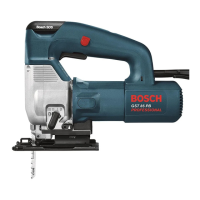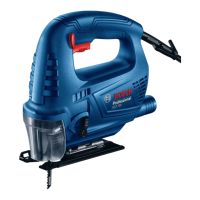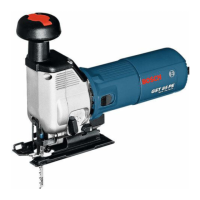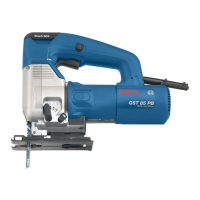8 | English
Sawdust blower device
The cutting line can be kept clear of chips using the airflow
from the sawdust blower device.
Switch on the sawdust blower device for work in wood,
plastic, etc. with a high level of material removal. Do this by
sliding the switch(6) to the "I" position.
Switch off the sawdust blower device when working in
metal. Do this by sliding the switch(6) to the "0" position.
Starting Operation
u Pay attention to the mains voltage. The voltage of the
power source must match the voltage specified on the
rating plate of the power tool. Power tools marked
with 230V can also be operated with 220V.
Switching on/off
u Make sure that you are able to press the On/Off switch
without releasing the handle.
To switch on the power tool, press the on/off switch (3).
To lock the on/off switch (3), keep it pressed down and
push the locking mechanism (2) to the right or left.
To switch off the power tool, release the on/off switch (3).
If the on/off switch (3) is locked, press the switch first and
then release it.
Constant Electronic control
The Constant Electronic control keeps the stroke rate at no
load and under load virtually consistent, guaranteeing uni-
form performance.
Controlling/preselecting the stroke rate
You can variably adjust the stroke rate of the power tool
when it is on by pressing in the on/off switch (3) to varying
extents.
Applying light pressure to the on/off switch (3) results in a
low stroke rate. Applying increasing pressure to the switch
increases the stroke rate.
It is not possible to reduce the stroke rate while the on/off
switch (3) is locked.
You can also preselect the stroke rate and change it during
operation using the stroke rate preselection thumbwheel
(4).
The required stroke rate is dependent on the material and
the work conditions and can be determined using practical
tests.
It is recommended that you reduce the stroke rate when
placing the saw blade on the workpiece and when sawing
plastic and aluminium.
During prolonged periods of use at a low stroke rate, the
power tool may heat up significantly. Remove the saw blade
and let the power tool run at the maximum stroke rate for
around three minutes to cool down.
Working Advice
u Pull the plug out of the socket before carrying out any
work on the power tool.
u Switch the power tool off immediately if the saw blade
becomes blocked.
u Always use a sturdy support when working on small or
thin workpieces.
Before sawing into wood, chipboard, building materials,
etc., check for and remove any foreign objects such as nails,
screws, etc.
Plunge cutting (see figureD)
u Plunge cuts may only be applied to soft materials,
such as softwood, gypsum board, etc.
For plunge cutting, use only short saw blades.
Place the power tool so that the front edge of the base plate
(5) rests on the workpiece, without the saw blade (10)
touching the workpiece, and switch it on. On power tools
with stroke rate control, select the maximum stroke rate.
Press the power tool firmly against the workpiece and allow
the saw blade to plunge slowly into the workpiece.
As soon as the base plate (5) rests fully on the workpiece,
continue sawing along the required cutting line.
Parallel guide with circle cutter (accessory)
When working with the parallel guide with circle cutter (17)
(accessory), the workpiece must be no more than 30mm
thick.
Parallel cuts (see figureE): Loosen the locking screw (16)
and slide the scale on the parallel guide through the guide
(12) in the base plate. Adjust the desired cutting width as a
scale value on the inside edge of the base plate. Retighten
the locking screw (16).
Circular cuts (see figureF): Drill a hole large enough to push
the saw blade through on the cutting line within the circle to
be cut. Machine the drill hole with a router or file so that the
saw blade can lie flush with the cutting line.
Position the locking screw (16) on the other side of the par-
allel guide. Slide the scale on the parallel guide through the
guide (12) into the base plate. Drill a hole in the workpiece
in the middle of the section to be cut out. Insert the centring
tip (18) through the inner opening of the parallel guide and
into the drilled hole. Adjust the radius as a scale value on the
inside edge of the base plate. Retighten the locking screw
(16).
Coolant/lubricant
As the material heats up along the cutting line when cutting
metal, you should apply coolant or lubricant.
Maintenance and Service
Maintenance and Cleaning
u Pull the plug out of the socket before carrying out any
work on the power tool.
u To ensure safe and efficient operation, always keep
the power tool and the ventilation slots clean.
In order to avoid safety hazards, if the power supply cord
needs to be replaced, this must be done by Bosch or by an
1 609 92A 52B | (19.06.2019) Bosch Power Tools

